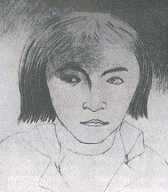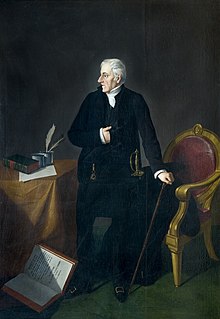 W
WLouis-Michel Aury was a French privateer operating in the Gulf of Mexico and the Caribbean during the early 19th century.
 W
WNicolás Bravo Rueda was the 11th President of Mexico and a soldier. He distinguished himself in both roles during the 1846–1848 U.S. invasion of Mexico.
 W
WCarlos María de Bustamante Merecilla was a Mexican statesman, historian, journalist and a supporter of Mexican independence. His historical "work early initiated an important Mexican national tradition of searching out and publishing basic materials on the Indian past and its fate in the colonial period." His writings in the 1820s shifted "the antiquarian bias of creole patriotism...into the ideology of a national liberation movement."
 W
WJosé María Gómez de Cervantes y Altamirano de Velasco Padilla y Ovando, Count of Santiago de Calimaya and Marquess of Salinas, was a Mexican army officer who signed the Act of Independence of the Mexican Empire along Agustín de Iturbide and his uncle, Juan María Cervantes y Padilla.
 W
WJosé Miguel Domínguez Alemán was a New Spanish colonial official in New Spain who played a part in the Mexican independence movement. He was also a member of a transitional governing committee in the period between the abdication of Mexican Emperor Agustín de Iturbide and the installation of Guadalupe Victoria as the first president of independent Mexico. His wife, Josefa Ortiz de Domínguez, also known as La Corregidora, was a heroine of Mexican independence.
 W
WFrancisco Ignacio Elizondo Villarreal,, was a royalist military officer during the Mexican war of independence against Spain. He is mostly known for his capture of insurgent leaders Miguel Hidalgo, Ignacio Allende, José Mariano Jiménez, and Juan Aldama at the Wells of Baján, Coahuila in 1811. Initially a supporter of Mexican independence who converted to the royalist cause, Elizondo is sometimes compared to the American Benedict Arnold. In 1813, after a successful campaign against rebel armies he was assassinated by one of his junior officers.
 W
WHermenegildo Galeana was a hero of the Mexican War of Independence, one of six brothers who fought in the insurgency. Galeana was considered the right-hand man of secular priest and leader of independence, José María Morelos and was the immediate superior of insurgent fighter Vicente Guerrero. Guerrero was of Afro-Mexican mixed-race from the west coast of Mexico where there was considerable racial mixture of the indigenous Indians, Africans and Asians brought to Mexico as slaves. Also part of the mix were non-hispanic pirates who operated on the west coast, which was a stronghold for independence. Galeana's family were landholders and "family name is said to be hispanicized from English," with the founder in Mexico being an English pirate who jumped ship, marrying a local woman. His portrait shows him as light-complected in a region with many dark morenos. Galeana died in battle, which followed the earlier death of Morelos's lieutenant, Father Mariano Matamoros, Morelos reportedly exclaimed, "I have lost both my arms, now I am nothing."
 W
WVicente Ramón Guerrero Saldaña was one of the leading revolutionary generals of the Mexican War of Independence. He fought against Spain for independence in the early 19th century, and later served as President of Mexico, coming to power through a coup in the aftermath of a disputed election in 1828.
 W
WMariano Matamoros y Guridi was a Mexican Roman Catholic priest and revolutionary rebel soldier of the Mexican War of Independence, who fought for independence against Spain in the early 19th century.
 W
WJosé Mariano Michelena was a Spanish military officer in New Spain and Spain, a precursor of Mexican independence, and a politician in independent Mexico. He introduced coffee to Mexico.
 W
WGeneral Martín Francisco Javier Mina y Larrea, nicknamed El Mozo or El Estudiante (Student), was a Spanish lawyer and army officer, who later became a Mexican independence figure.
 W
WJosé María Teclo Morelos Pérez y Pavón was a Mexican Roman Catholic priest and revolutionary rebel leader who led the Mexican War of Independence movement, assuming its leadership after the execution of Miguel Hidalgo y Costilla in 1811. Morelos and Ignacio López Rayón are credited with organizing the war of independence. Under Morelos the Congress of Anáhuac was installed on 13 September 1813, and in 6 November of the same year congress declared the country's independence. On 22 October 1814, a constitution, Decreto Constitucional para la Libertad de la América Mexicana, was drafted by the Congress which declared that Mexico would be a Republic.
 W
WPedro Moreno Gonzalez, was an insurgent in the Mexican War of Independence.
 W
WAntonia Nava de Catalán was a heroine of the Mexican War of Independence. She accompanied her husband, a volunteer who rose to the rank of colonel, throughout the war. Three of her sons were killed in the struggle. She is remembered for her willingness to sacrifice her family and herself to achieve independence from Spain, and came to be known as "La Generala". She fought alongside Jose Maria Morales until her death.
 W
WMaría Rita de la Trinidad Pérez Jiménez, commonly known as Doña Rita Pérez de Moreno, was an insurgent and heroine of the Mexican War of Independence, along with her husband Pedro Moreno.
 W
WEl Pípila is the nickname of a local hero of the city of Guanajuato in Mexico. His real name was Juan José de los Reyes Martínez Amaro (1782–1863), son of Pedro Martínez and María Rufina Amaro. He married a woman named Maria Victoriana Bretadillo and had three children, Manuela, Doroteo and Francisca. Word for a hen turkey, it is said his nickname stands for his freckled face or his laughter resembling the bird's peculiar gargle.
 W
WVíctor Rosales;, was a Mexican military officer born in Zacatecas, in the central Viceroyalty of New Spain. Rosales was a field marshal in the Mexican War of Independence.
 W
WPedro Sáinz de Baranda y Borreiro was a Naval Officer, Industrialist and Liberal Politician who served in the Spanish Navy and, having participated in the Mexican War of Independence, is credited with founding the Mexican Navy. During 1835, he served on two occasions as Governor of Yucatán. As an entrepreneur, he founded the first completely mechanized textile factory to use steam-power successfully in Mexico; he is widely regarded as having introduced the Industrial Revolution to the country.
 W
WJosé Manuel Rafael Simeón de Mier y Terán, generally known as Manuel de Mier y Terán, was a leader in the Mexican War of Independence and in the post-independence period was a military figure and politician.